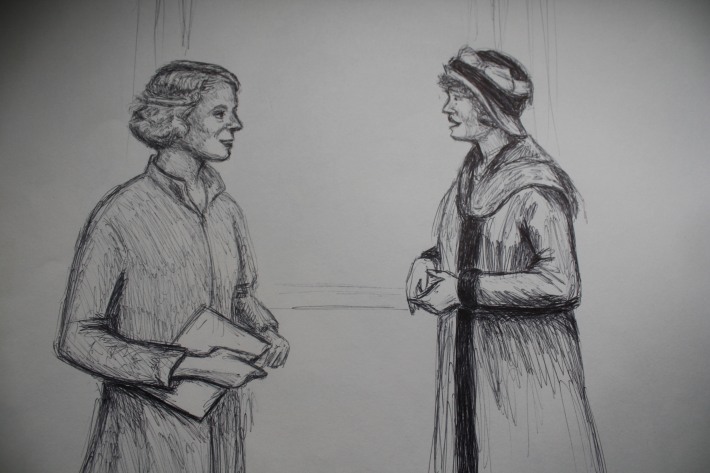Between 1991 and 1994 BBC broadcasted the series The House of Elliot, a story about the sisters Beatrice (Bea) and Evangeline (Evie) who in the 1920′s establish a dressmaking business and later their haute couture fashion house in London. When the story begins they are left more or less pennyless when their father has died, and Bea, 30, and Evie, 18, have a tough start. They meet the photographer Jack Maddox with whom they become close friends.
The story is a good example of strong, independent women, and a description of one form of feminism where women take the command of their own lives. For a long time we men have had a dominant role in society, and oppressed women through the ages, even though there are evidence of women who have opposed that during the last millennia or two. Feminism as a more distinct movement has existed during a little more than 200 years. The two original forms have been liberal and socialist feminism respectively. In 1792 Mary Wollstonecraft wrote “A Vindication of the Rights of Woman” in which she deals with the subjugation of women and how women should have the same rights as men.
Here in Sweden two women who had an impact during those days were Sophia Adlersparre and Fredrika Bremer. As an example of that are the effects of the novel Hertha which Fredrika Bremer got published in 1856. In that novel she described the young woman Hertha who didn’t want a forced marriage, but economic independence and freedom from her guardian. Two years after the book was published the Swedish Parliament gave women the right to apply for coming of age and legally independent when they were 25. In 1861 a school for women teachers was established inspired by passages in the novel Hertha.
The first country that gave women the right to vote though during the 1800′s was New Zealand. Another example of female progress was higher education. Here in Sweden the universities were meant for male students only, but a few women got into that environment and started to study, even though they were harassed by male students and professors. Today female students often dominate many University programs in Sweden, even though the surrounding society often still is unbalanced in the opposite direction.
Feminists struggle for women’s emancipation. In the beginning of the last century the struggle often concerned the right to work outside the home and the right to vote. In many western countries the fight looked similar and the right to vote in elections was gained mostly during the 1920′s. Swedish women got the right in 1919, and went to elections first in 1921. After that right was won, during most of the 20′th century, women have struggled for sexual rights, the right to decide over their own bodies, for the right to abortion if they become violated for example, for equal salaries between men and women, rights to education and possibilities to reach high positions in society, fight against pornography, for harder punishments for rapes etc.
In 1979 the UN established CEDAW which deals with women’s rights. Sweden was one of the first countries that ratified the convention which became valid in 1981. Since the 1990′s the feminists have gained strength, but are also both silently and violently opposed from different directions. There are also several differences among the many different forms of feminists. The socioeconomic background, the political agenda, religious or atheist ideology. Today there are several feminist subgroups: equality feminism, specific type feminism, liberal feminism, socialist feminism, radical feminism, anarchy feminism, queer feminism, pragmatic feminism and continental feminism.
Our new Swedish Minister of Equality Maria Arnholm from the Liberal “People’s Party/Folkpartiet, says with fervor that she’s a feminist, and she has no doubt for many years already been working for developing and securing the lives and rights of women in this country. Her predecessor in the present Conservative-Liberal government was Nyamko Ana Sabuni who came to Sweden from Burundi as refugee at the age of 12. She later turned to politics, and was a Member of Parliament 2002- 2006. In 2006 when the Conservative-Liberal fraction won the elections Nyamko Sabuni was given the post as Minister of Integration 2006 – 2010, Minister of Gender Equality 2006 – 2013 and Deputy Minister of Education 2010 – 2013. Now Maria Arnholm is the new Minister of Gender Equality. As a Liberal with a well-educated and privileged background she naturally has a slightly different outlook and agenda than for example Gudrun Schyman, the former leader of the Communist Left Party, now leader of “Feminist Initiative”. Abroad there are many varieties as well of organizations that work for women’s rights, gender equality, against honor-related violence/gender violence. The French organization from 2003 “Ni putes ni soumises”/Neither whores nor subjugated”, here in Sweden called “Varken hora eller kuvad” is one example. On Facebook a new group was formed in late 2011 called “The Uprising of Women in the Arab World”. These are just two of many examples. Feminists may be very different and diversified in perceiving their womanhood, but I hope that they will find their inner strength and ways to solve some of the conflicts that do exist. We men must also find ways to treat the opposite sex in a good way, feel an inner security and meet the women in acceptance and love. I believe that both men and women ought to try and listen in each other’s wishes and perspectives to prevent the negative trend of mutual gender hate. As two very different aspects of treatment of women and gender hate I tomorrow will write not just one, but two different texts dealing with both men’s violence against women, and the importance of good love between the sexes, since it’s also S:t Valentine’s day tomorrow.
//Anders Moberg, February the 13th 2013

